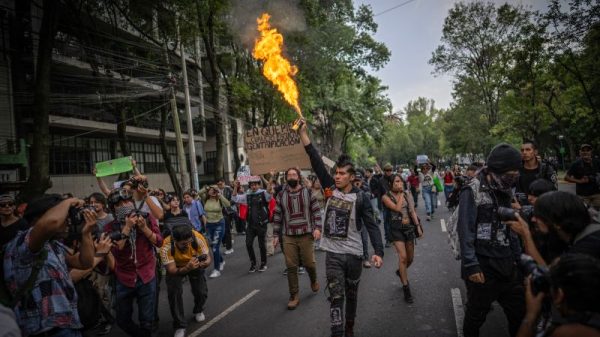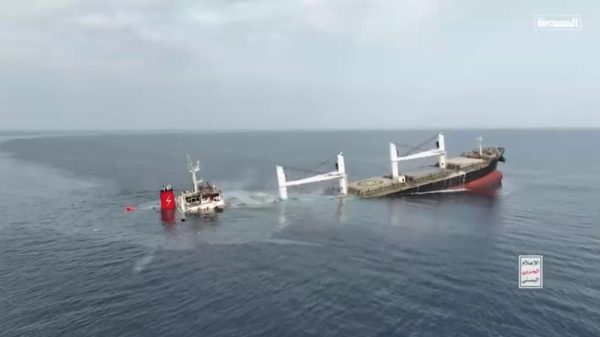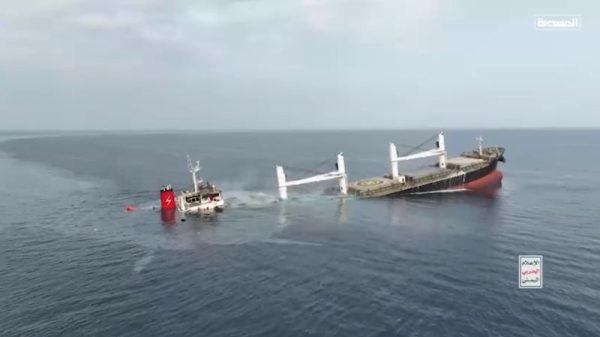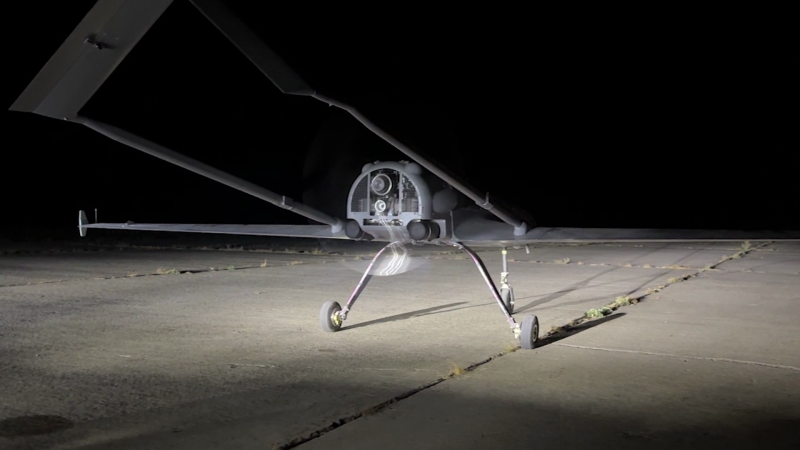The spluttering roar of a propeller punctuates the perfect silence. Car headlights flick on, splitting the darkness. Their beams reveal not just a section of tarmac ahead, but one of Ukraine’s most top-secret weapons, controlled by its most clandestine agency.
Stuck to the nose of the gray machine is a yellow emblem of an owl, wings spread and grasping a sword – the unmistakable logo of Ukraine’s defense intelligence, the GUR.
Two pilots sporting the same owl patches on their fatigues make their final checks inside the car before a thumbs up: “Let’s go!”
A high-speed, 50-second chase ensues, before the 13-foot long, 23-foot wingspan AN-196 Liutyi drone disappears in an instant into the inky-black Ukrainian night.
The drone’s destination is a target deep inside Russian territory.
Only two people were authorized to speak on the record, and then only using their callsigns: Serge, the long-range drone operations commander of GUR, and Vector, unit commander. Serge said he had personally overseen more than 500 long-range drone attacks into Russia since its full-scale invasion of Ukraine in February 2022.
Their target: an ammunition facility, specifically train carriages sitting inside the depot loaded with recently delivered Iranian missiles, according to the Ukrainians.
The facility sits on the outskirts of the tiny village of Kotluban, in the Volgograd region of southwestern Russia.
Long-range drone attacks have become an increasingly prominent part of the Russia-Ukraine war. As the land war has become more attritional, the air war has gathered speed, with the major development being in drone warfare.
In September, the unit’s drones hit a Russian ammunition depot between Moscow and St. Petersburg, in Tver region. The attack on Toropets, the Ukrainians claimed, resulted in the destruction of a depot storing Iskander tactical missiles, as well as aerial glide bombs and artillery munition. The strike caused massive explosions, visible for miles.
And in July the Ukrainians say they hit an oil refinery on Russia’s Black Sea coast, causing a major fire there.
Russian President Vladimir Putin has warned, however, that Moscow would consider any assault on it supported by a nuclear power to be a joint attack, singling out a mass launching of drones as one potential example.
Vector said many of Russia’s airfields, the origin-point of many of the air raids it conducts against Ukraine, are out of range. His drones, while highly effective, are not always that efficient – swarms of them are required to ensure their targets are hit. “Of course, we can send the UAVs (unmanned aerial vehicles), and we destroyed many places. But it’s not enough,” Vector says.
“We’re not asking only about the permission to send the missiles anywhere in Russia, we speak about the weapons which can help us to move this war from our territory,” Vector adds.
Inside the mission
Serge and Vector have been leading their unit’s attempts to hurt Putin at home.
Regardless of targets, their missions follow a rigid set of operating procedures that include meetings at various locations across Ukraine.
In an underground office with dark brown, seemingly never-ending Soviet corridors, Serge sits across from Vector in a white-walled room. No pictures hang on the wall, even the whiteboard remains blank. The meeting is to the point.
“There will be about 12 drones,” Serge says to Vector, who has a map in front of him detailing the target and range of the Russian air defense and electronic warfare systems. They then agree the target approach time of around 3 am and the launch intervals for the drones.
Vector scribbles two notes before standing abruptly and saying, “Everything is clear. Ready to complete the task.”
As dusk draws in, the convoy pulls into a compound, articulated lorries lined up. A tiny room with a desk and two sets of bunk beds serves as the only light source for miles around.
Men dressed in black, balaclavas over their faces, wait to hear their orders. Vector delivers a short brief, adding that this mission will also involve other units. He orders his men to start preparing the routes and hands over a small USB key containing the information for the mission ahead.
“Any questions?” he asks. “None? Okay. Let’s get working.”
He points to the quality of Russia’s air defenses, especially over the past 12 months. “We’re successful guys and we find the windows,” he says, but it’s a challenge.
Each drone will be programmed with more than 1,000 different waypoints, to evade Russia’s comprehensive air defense systems. There is tacit acceptance from Vector that some of this resembles a video game.
“It looks like we play with them,” Vector says jokingly, “but it’s not a game. It’s a war.”
Serge adds that not all men in his unit are career soldiers like him. He has served more than 20 years in the Ukrainian army and began flying drone missions in 2014 as Russian-backed separatists in Ukraine’s eastern Donetsk and Luhansk regions split away from Kyiv.
Decoy machines
In a warehouse, a Liutyi drone, produced predominantly in Ukraine, wingless for the time being, stands surrounded by green camouflage-painted crates containing multiple Rubaka kamikaze drones.
Vector explains that these smaller drones are crucial to the success of any mission. The aim is simple: to overwhelm the air defenses and draw Russian fire away from the Liutyi, which often carries a payload as great as 250 kilograms (550 pounds).
“They’re very simple, and we can use them with and without payloads,” he says of the smaller drones.
Cracking open one of the crates, he pulls out one of the decoy machines. Strips of metal foil have been added to the wings to fool Russian radar.
“We try to mix them, and we try to send them from different distances, different launch places… they try to destroy them. They send helicopters and missiles, they turn on the radio electronic warfare,” Vector explains.
Their targets are only military targets, Vector states. “Russia came inside our country. They destroyed a lot of electricity, a lot of houses, cities, villages.” But, he adds, “not all of them are stupid, and when they understand that war can come to them like they come to us, they will change something in their country. They will change the politics.”
One of the many articulated lorries has backed up for loading. In near darkness, drone bodies, followed by wings, are loaded three per truck by men whose faces are totally covered by balaclavas, and strapped down, ready to be taken to their launch sites.
Across other parts of Ukraine roughly 80 other GUR operatives are preparing 90 other drones, not all the Liutyi, for flight.
Some 30% of all the drones being launched will be on decoy missions, Serge says. The drones have been programmed to fly anywhere between 450 and 550 miles, with the Liutyis being the spearhead, destined for the small town-turned-ammunition hub of Kotluban.
The men load the warheads carefully into the bodies of the drones. Each compartment is then sealed with the squeal of a drill.
Serge and Vector, now in full combat uniform, observe the final preparations. This launch is one of the largest Serge has ever conducted, he says.
“Maybe (the Russian people) don’t understand what’s going on in Ukraine, but when these UAVs arrive, they understand clearly what we have been living (with) for the past 10 years,” Vector chimes in.
Tracking the drones’ flight
In total darkness, the drones are pushed into position. The car with the pilots moves in behind. The propeller spurts into life and the pilots ensuring a smooth takeoff begin their high-speed chase down the tarmac. Once airborne the fully autonomous drone starts ticking off the myriad waypoints.
Vector hurtles after the drone before slamming on the brakes and proclaiming “perfect.” He turns the car around and blasts a patriotic song from his radio.
Back at the planning base, the hours tick by and Vector, Serge and others keep tabs on the drones via trackers.
The success of the mission is monitored in three ways, they say: through human intelligence on the ground, the messages seen on Russian Telegram groups and, later, analysis using satellite technology. Only once all three have been assessed can a mission be deemed a success or not.
As the 3 am arrival window nears, Serge starts reading out messages he is seeing from Telegram channels across Russia. The widespread nature of this attack starts to become clearer. Various cities in southern Russia – Voronezh, Yesk, Rostov and Volgograd – all start reporting drones arriving in their airspace.
One video from Voronezh shows one of the decoy drones whizzing overhead. An audio clip of a woman in clear distress at what is happening above her head leaves Vector laughing.
Through these Telegram channels, he says, “we understand that we are having some success.”
Initial satellite imagery of the ammunition depot in Kotluban shows scorched fields, a result of burning grass, but seemingly little evidence of major explosions within – apparent signs of a near miss.
The video, sped up, shows 11 explosions all occurring in a 56-minute timeframe between 2:22 and 3:18 am – exactly the period during which the drones arriving from Ukraine were expected to land.
The image shows a number of objects scattered around the building and a building badly damaged.
The mission to destroy Iranian-delivered missiles was a total success, the Ukrainians insist.

































